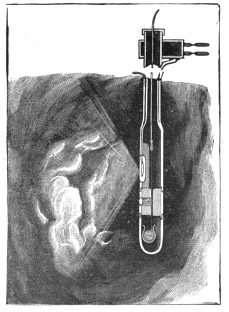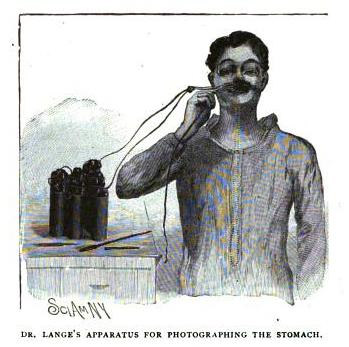
Serial : The American amateur photographer ; vol. 11.
New York : The Outing Company, ltd., 1899.
Description : pages 435-436.
Subject : Stomach — Medical photography.

Dr. Max Einhorn, of New York City, made a communication to a medical journal some seven years ago regarding "gastrodiaphany," in which a miniature Edison lamp in a special mounting attached to a soft rubber tube containing a wire was introduced into the stomach so that an examination can be made of it. This method was called "gastrodiaphany," as the stomach became translucent. The object of this device was to show the size and situation of the stomach to the eye and also to recognize tumors or other gross anatomical changes of the anterior wall of the stomach. This was, of course, a different apparatus than the "polyscope," which is used for looking into the stomach, and was not intended to replace any such device. It has been found to be of considerable value to surgeons.
In the same paper Dr. Einhorn described a camera for photographing the interior of the stomach, but owing to technical difficulties, the camera was not constructed by Dr. Einhorn. Such a camera has, however, been perfected by Dr. Fritz Lange, of Munich, Germany, on almost the identical lines given by Dr. Einhorn.
Through"the courtesy of Dr. Lange we are enabled to present an accurate illustration of the device employed. The camera is a marvel of compactness, and is constructed on exactly the same principles as all cameras for taking moving photographs, although, of course, there is no attempt made to combine them so as to project the actual operations of the stomach. The camera itself is swallowed by the patient, and it contains a small electric lamp for illuminating the walls of the stomach. A photographic film twenty inches long and a quarter of an inch wide is wound at the bottom of the camera. One end of the film is fastened to the cord, which runs freely in the tube. When the cord is pulled, the film is drawn slowly past the lens. The cord and

the conducting wires must, of course, be swallowed with the camera itself. When the camera
reaches the bottom of the stomach the surgeon begins to pull the cord, which runs the film past
the lens. The electric light is then turned on, and. after the sensitive film has been impressed
with the image, the current is turned off and another section of film is brought into play until the
requisite number of pictures have been obtained, then the entire apparatus is withdrawn from the
stomach of the patient and the films are carefully developed and enlarged.—Scientific American.
